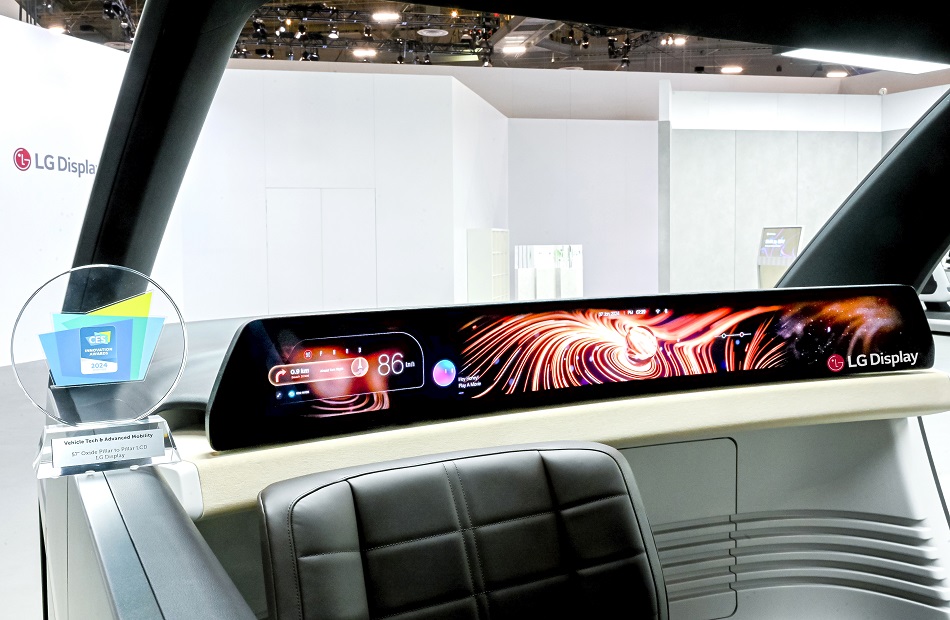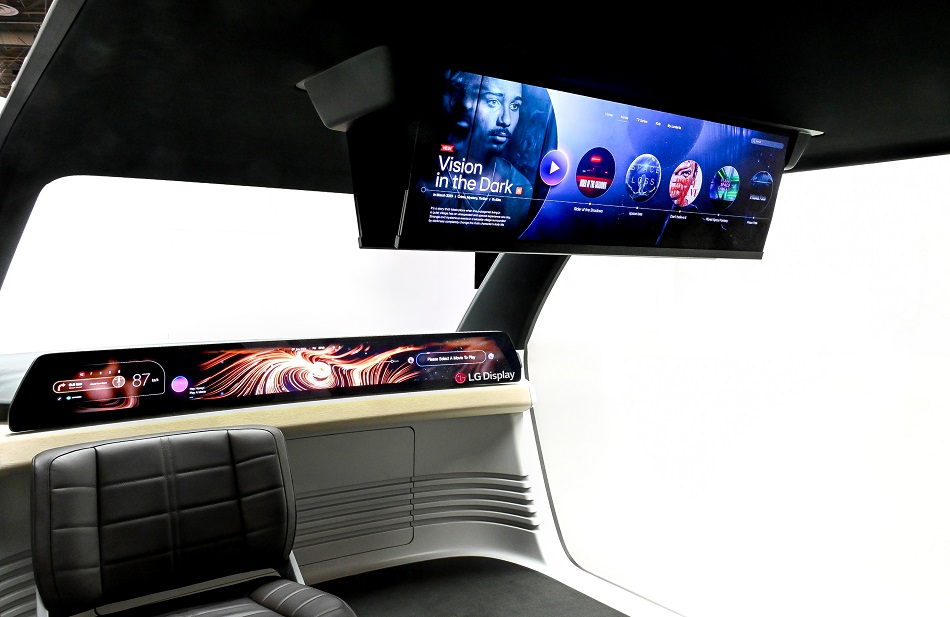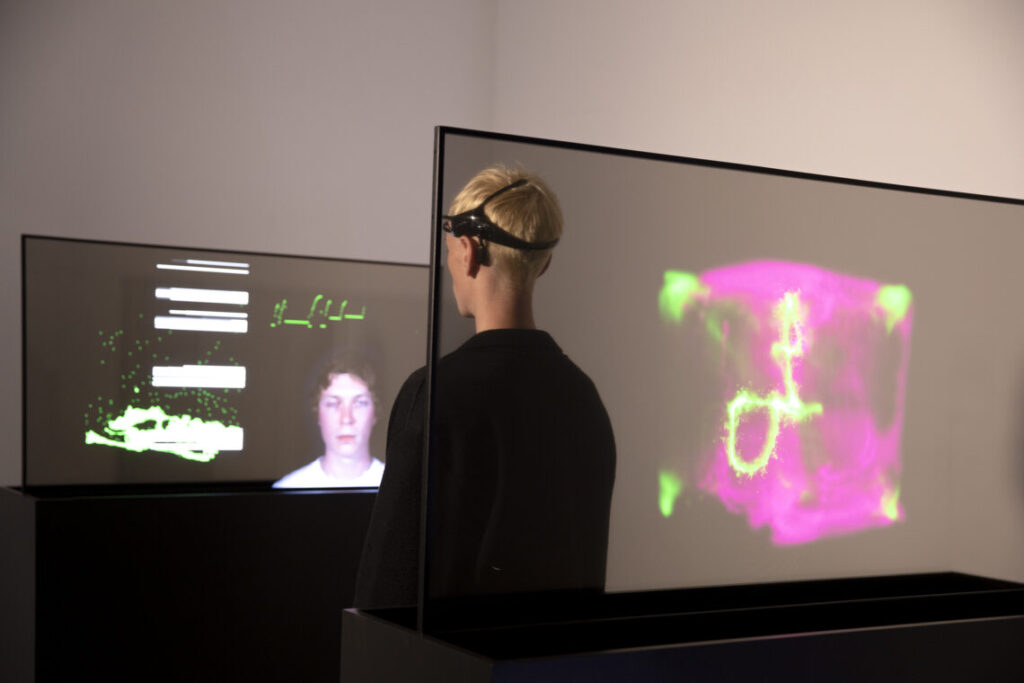SEOUL, Korea (Jan. 09, 2024) – LG Display, the world’s leading innovator of display technologies, announced today that it is showcasing a series of ultra-large automotive display solutions, including the world’s largest automotive display, to accelerate innovations for future cars at CES 2024.

At its dedicated booth for automotive displays in the West Hall of LVCC, LG Display unveiled the world’s largest automotive display, the ’57-inch Pillar-to-Pillar (P2P) LCD,’ and largest slidable panel, the ’32-inch Slidable OLED,’ for the first time.
To demonstrate its future vision for mobility, LG Display is introducing three concept cars equipped with automotive display solutions optimized for each stage of the development of Software Defined Vehicles (SDVs). These stages are called Shift, Evolution, and Beyond.
First, LG Display unveiled ultra-large display solutions designed for SDVs, which are characterized by “screenification,” a concept that denotes the recent increase in the size and number of automotive displays that enable drivers and passengers to control a multitude of functions.
The ’57-inch Pillar-to-Pillar LCD,’ the world’s largest single panel for automotive displays, covers the entire dashboard from the driver’s seat to the front passenger’s seat. With its ultra-large size, high-definition picture quality, reliability, durability, and exceptional design, the 57-inch P2P LCD has been recognized by the Consumer Technology Association (CTA) with a ‘CES® 2024 Innovation Award’ for offering new mobility experiences for passengers.
Featuring a maximum curvature of 3,500R (or a curvature radius of 3,500mm), the 57-inch P2P LCD provides various driving information, climate controls, and other vehicle information at a glance and allows passengers to enjoy various content, such as movies or games, in high definition with exceptional touch responsiveness thanks to LG Display’s proprietary ‘In-Cell Touch’ technology.
Unlike traditional panels, the 57-inch P2P LCD functions well in extreme temperatures ranging from -40°C to 85°C, boasting the reliability and durability required for an automotive display.

The ’32-inch Slidable OLED,’ the largest sliding panel in the world, is hidden in the ceiling and can be extended downward to form a large interior screen. With a maximum curvature of 30R (or a curvature radius of 30mm), its slim design doesn’t require much space even when rolled up, providing maximum space efficiency in the limited confines of a vehicle. When in use, the 32-inch Slidable OLED delivers a QHD (2560×1440) resolution to increase immersion as well as high-sensitivity touch features for enhanced gaming, video conferences, and more.
In addition, LG Display is also introducing other ultra-large automotive display solutions such as the ‘Ultra-large P-OLED P2P,’ which combines a ‘12.3-inch P-OLED’ display cluster with the ’34-inch P-OLED’ center fascia display to form a large singular display, and the expansive ’48-inch LTPS (Low-Temperature Polysilicon) LCD’ that seamlessly connects the dashboard from the driver’s seat to the passenger’s seat.
LG Display is bolstering its position as the global leader in automotive displays by expanding its automotive display business based on differentiated technologies, such as P-OLED, ATO (Advanced Thin OLED), and LTPS LCD.
The ultra-high-resolution P-OLED lineup features a flexible plastic substrate for a lightweight and flexible panel. ATO, on the other hand, utilizes glass substrates to offer the core strength of automotive OLED at a more competitive price point. In addition, LTPS LCD is a high-performance panel that enables larger and higher-resolution displays compared to existing LCDs.
Notably, LG Display’s Automotive OLEDs consisting of P-OLED and ATO incorporate the company’s pioneering Tandem OLED, a groundbreaking two-stack OLED technology that adds an extra organic emitting layer for brighter screens, optimal stability, and longer lifespans compared to single-layer OLEDs.
Last year, LG Display began the mass production of its second-generation Tandem OLED, which features higher brightness and enhanced durability while reducing power consumption by 40%. This year, the company has started developing its ‘third-generation Tandem OLED’ to further bolster brightness levels and power consumption over its predecessor.
Based on LG Display’s product and technological competitiveness, the company secured ten premium global automakers across Europe, North America, and Korea within just four years of initiating the mass production of its Automotive OLEDs.
To solidify its position in the ultra-large automotive display market, LG Display is establishing a two-track production system in response to increasing demand for ultra-large automotive displays above 30 inches. With plans to begin mass production of automotive displays at its Paju plant after 2025, following its plant in Gumi, LG Display recently obtained the prerequisite international quality standard certification (IATF16949).
“Through our robust customer base, unmatched technologies, stable supply and quality, and dedicated Fab operation, we aim to create the world’s best automotive display business,” said Byeong-koo Kim, Senior Vice President and Head of Auto Business Group at LG Display.
Also in its booth, LG Display has divided the development of the SDV into three stages and created a zone for each one.
The Shift to SDV Zone illustrates the expanding size of automotive displays as SDVs gradually become the norm. Here, LG Display’s ‘Ultra-large P-OLED P2P’ enables passengers to conveniently access features like basic driving controls and content viewing.
In the back, Rear Seat Entertainment (RSE) in the form of the ’17-inch Foldable OLED’ is integrated into the cabin, allowing rear passengers to enjoy movies on a large screen or even fold their display into a 12.3-inch tablet, providing a new experience that goes well beyond the capabilities of any conventional displays.
In the Evolution of SDV Zone, LG Display is presenting “user-centric solutions” including the ‘Pop-up-type 48-inch LTPS LCD’ and ’18-inch Slidable OLED’ that activate based on the passenger’s needs to curate a space where driving and relaxation coexist.
To help achieve perfect harmony between the display and the cabin, a new ‘Decorative Film’ is attached to the screen to resemble interior materials used in vehicles, such as carbon or wood, when not in use.
In addition, the proprietary ‘Thin Actuator Sound Solution,’ which is just 30% of the weight and 10% of the thickness of a conventional car speaker, can be installed in various parts inside the vehicle, such as the display, ceiling, and floor, to produce a rich, 3D-immersive sound experience that surrounds the passenger.
In the Beyond SDV Zone, where fully autonomous driving is achieved, LG Display is showcasing various ultra-large automotive displays throughout the cabin, including the 57-inch P2P LCD and the 32-inch Slidable OLED that replace the steering wheel and help transform the vehicle from a means of transportation into a personalized living space.
As the autonomous vehicle navigates towards its destination, front seat passengers can utilize the 57-inch P2P LCD to attend video conferences, while rear seat passengers can enjoy movies on the 32-inch Slidable OLED’ that retracts from the ceiling, allowing all passengers to indulge in work and leisure while on the road.








